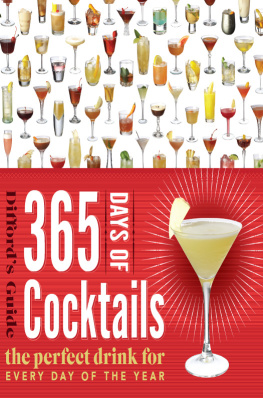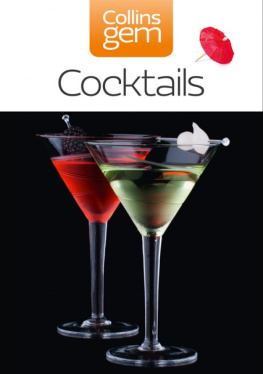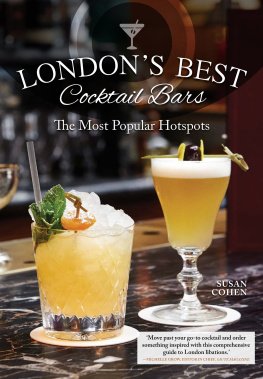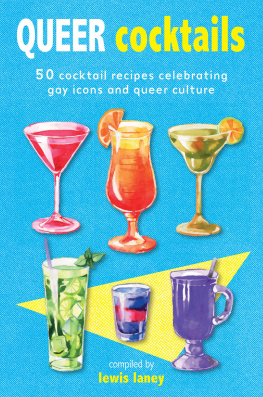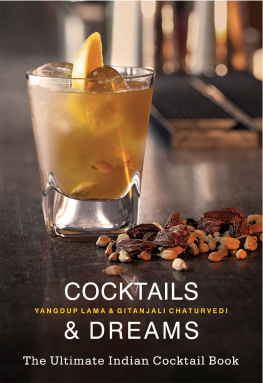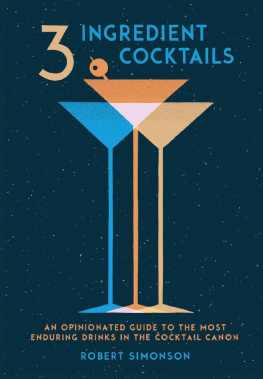Contents
Guide
This book evolved from our Cocktail of the Day on diffordsguide.com, which I was inspired to start during a visit to Barcelona back in 2009. I noticed that many of the old-school cocktail bars such as Ideal, Tandem and Boadas have signs behind the bars that say Cctel del Da and suggest a cocktail. I asked one bartender why the bar had chosen a particular cocktail to recommend for that day. Disappointingly but honestly, he replied that they had a number of cocktails that they simply rotated.
It occurred to me that with more than three thousand cocktails on our website we should be able to find an appropriate cocktail for each day, influenced by an event, anniversary or celebration. When we started our research, I was struck by the wonderful diversity of days that are celebratedeverything from Smile Power Day to the day that man first walked on the moonand how interesting many of them are. The background to each day cried out for a short explanation, so we decided to add one, rather than just listing an appropriate cocktail for a certain day.
At the time of writing this book weve run a Cocktail of the Day every day for more than five years on diffordsguide.com and weve picked 365 of the best of those cocktails and date combinations for this book. We hope youll enjoy reading about each day while sipping the appropriate libation. Weve also included some tips for novice cocktail makers, but if youd like further help, we suggest you watch our how-to videos on the cocktail section of diffordsguide.com.
METHODS
By definition, any drink that is described as a cocktail contains more than one ingredient. So if you are going to make cocktails, you have to know how to combine these various liquids.
As in cooking, there is a correct order in which to do things. With a few exceptions, it runs as follows:
1. Select glass and chill or preheat (if required)
2. Prepare garnish (if required)
3. Pour ingredients into mixing receptacle
4. Add ice (if required)
5. Mix ingredients (shake, stir, blend, etc.)
6. Strain (or pour) into glass
7. Add pre-prepared garnish (if required)
8. Serve to guest or enjoy yourself
Unlike cooking, where there are a myriad of preparation and cooking methods to master, there are essentially only eight different ways to mix a cocktail:
1. Build
2. Shake
3. Stir
4. Blend
5. Throw
6. Roll
7. Swizzle
8. Layer
The last, layering isnt strictly mixing. On the contrary, the idea here is to float each ingredient on its predecessor without the ingredients merging at allthink B52 cocktail. At the heart of every cocktail lies at least one of these eight methods, so understanding these terms is fundamental.
BUILDING
It is common for bartenders and bartending books to say build in glass. This simply means to combine ingredients in the glass it is to be served in. This is the usual method for making highball drinks such as a gin and tonic or a whiskey and soda.
SHAKERS AND SHAKING
When you see the phrase shake with ice and strain, or something similar, in a recipe, you should place all the necessary ingredients with ice cubes in a cocktail shaker and shake briskly. Dont be shy about itimagine how you might agitate the metal ball in a can of spray paint. Shake for around 15 seconds, then strain the liquid into the glass, leaving the ice behind in the shaker. Shaking not only mixes a drink, it also chills, dilutes and aerates it. The dilution achieved by shaking is just as important to the resulting cocktail as using the right proportions of the ingredients. If you use too little ice, it will melt too quickly in the shaker, producing an overdiluted drink, so fill your shaker at least two-thirds full with fresh ice.
Losing your grip while shaking is likely to make a mess and a flying shaker could injure a bystander, so always hold the shaker firmly with two hands and never shake fizzy ingredients (unless in a minute proportion to the rest of the drink).
DRY SHAKE
When making drinks containing cream and eggs, it is common practice among some bartenders to first shake the mixture in a shaker without ice, then shake the drink a second time with ice. (An increasingly common alternative is to shake with ice first and then again without ice.) This practice is known as dry shaking. The theory is that shaking without ice, and so at a higher temperature, allows the drink to emulsify better.
STIRRERS AND STIRRING
Stirring is one of the most basic ways to mix a cocktail. You might not give much thought to the technique used to stir a cup of tea or even a can of paint, but cocktails deserve a little more reverence.
Stirring glasses come in a multitude of shapes and sizes. If a specially designed lipped mixing glass is not available, a Boston glass (the glass half of a Boston shaker) or even the base of a standard shaker will suffice.
There are almost as many different styles of bar teaspoons on the market as there are stirring glasses. Some have spiraling stems, some have flat ends, and others have three-pronged fork ends. The key thing is for your spoon to have a long stem so that it will reach down to the base of the glass while allowing you to comfortably hold the stem of the spoon high above the mixing glass.
If a cocktail recipe calls for you to stir with ice and strain, then you should do so.
Measure your ingredients into your chilled stirring glass and then fill it two-thirds with ice.
Hold the bar spoon between your thumb and the first two fingers of your dominant hand, with the spoons shaft running between your middle finger and ring finger.
Slide the bowl of the spoon down the inside edge of the glass until it almost touches the base of the glass.
Keeping your arm still, and to an extent your wrist as well, use your fingers to pull the spoon toward and then away from you, aiming to hit the quarter-hour marks on an imaginary clock-face inside your stirring glass. As the spoon runs around, so it will spin the ice and liquid in the glass, while spinning on its own axis in your fingers.
Stir briskly for about 30 to 45 secondsthis should account for at least 50 revolutions.
Place your strainer into or over the stirring glass (see straining) and strain into your chilled serving glass. If the recipe calls for the drink to be served over ice, then you should add ice to your glass first. Never use the ice from the stirring glass in the drink itself.
The ice used during stirring is now spent and should be dumped, or alternatively can be left in the stirring glass to keep it chilled and ready for the next drink. If you do the latter, remember to dump the ice and rinse the glass with cold water before making the next drink.
STRAINING
When straining a shaken drink, a Hawthorn strainer is usually used, but when straining a stirred drink it is traditional to use a Julep strainer. Both designs of strainer allow the liquid to be poured from the shaker/stirring glass while restraining the spent ice.
Hawthorn strainers have a spring that runs around the circumference to help catch particles of ice and fruit created by the violent act of shaking. They also often have lugs that rest on the rim of the shaker to hold the strainer in position when being used. Most designs of Hawthorn strainers incorporate a ridge or finger rest, which when pushed serves to secure the spring-loaded gap between the strainer and the side of the shaker, allowing finer particles to be caught.
Julep strainers are best described as perforated metal spoons that fit inside the stirring glass. It is said that they take their name from Kentucky gentlemen who historically would hold them over a Mint Julep to keep the ice and mint off their mustaches. Julep strainers are not as efficient at catching small fragments of ice as Hawthorn strainers, but they are more pleasing to use in conjunction with a stirring glass.

